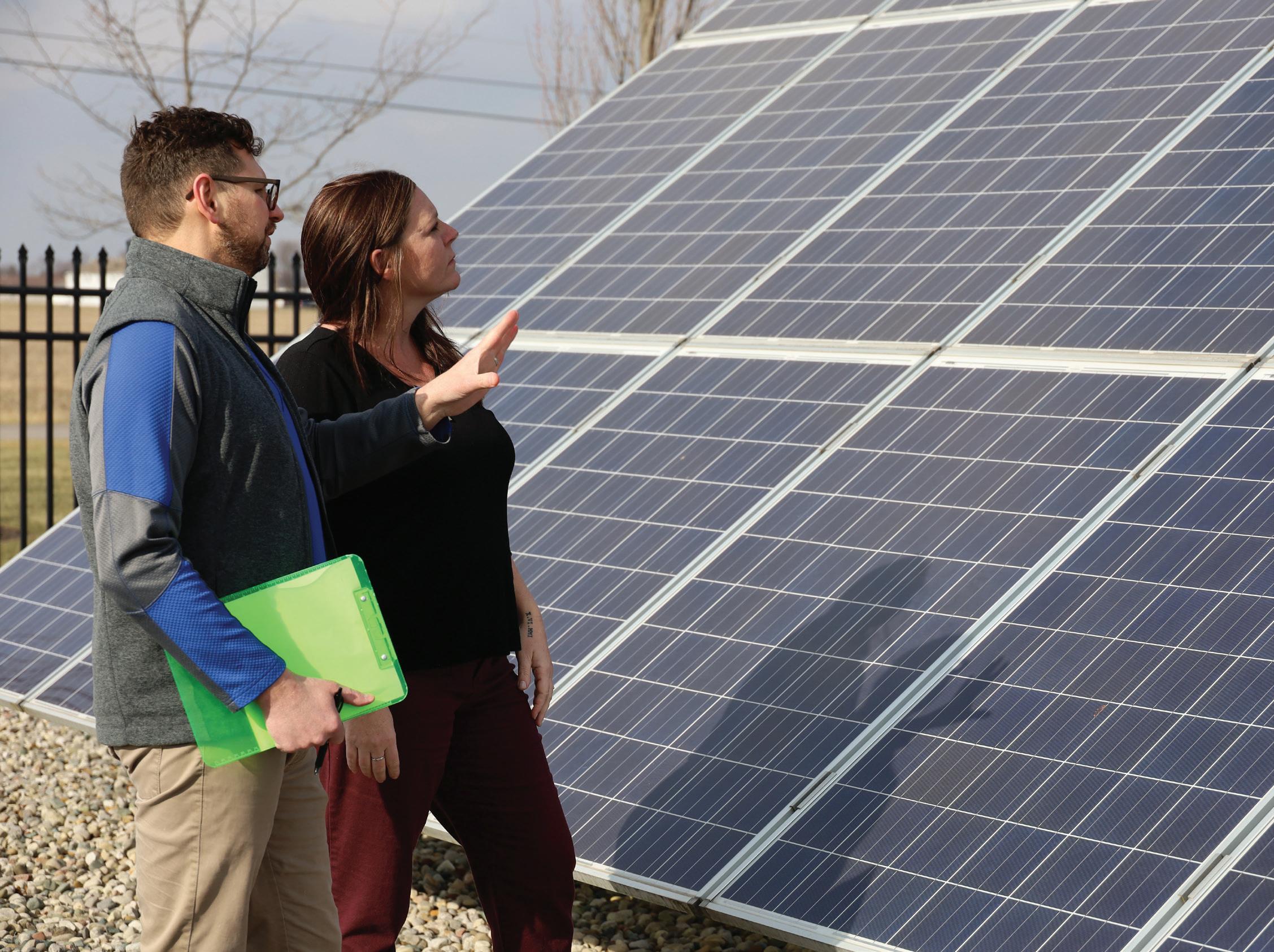
6 minute read
WOODS, WATERS AND WILDLIFE
Peter Niagu, energy advisor at Paulding Putnam Electric Cooperative, consults with a member about solar generation.
Will solar save me money on my electric bill?
Ray Crock, energy advisor at Guernsey-Muskingum Electric Cooperative, says, “The short answer is — of course it will save you money on your electric bill. But the real question is whether it will save you money overall, with the cost of solar accounted for.” Crock relates the story of a solar consultation and energy audit he performed a few years ago: “At that time, electricity was costing them about 14 cents per kWh, but the solar salesman told them that price was forecast to rise to 18 cents in five years. Here we are, five years later, and the cost is closer to 12.5 cents. It doesn’t make sense to invest in something that has a 20- to 30-year payback when it will be worn out in 20 to 25 years. My point is to really check the numbers — and have a sharp pencil.”
How much will a solar array cost?
“There are many factors that play into the cost of a solar array,” says Jacob Atkins, energy advisor at South Central Power Company. “One of the contributors of cost is the system size — the larger it is, the more it will cost overall, but it will have a lower cost per watt. The average cost per watt for a system is between $2.50 and $3.50. Another thing to account for is the installer that is putting in the system. Each installer has a different brand of equipment and cost of labor, which will affect the overall price. Also look out for permitting and interconnection fees. The municipality you live in could have permit fees, and your utility could have a fee for interconnecting your array. If taking out a loan, pay attention to the interest rate and associated terms that will impact your loan.”
Can I use batteries to store my energy?
“In a word, yes,” says Chris Bear, energy advisor for North Central Electric Cooperative. But it’s complicated. “You have to install an inverter that will convert the AC power into DC power and then choose where to send the power from the solar panels — either to the house, back to the grid, or to the battery storage system.” He continued, “Battery storage can be installed inside or outside of the structure. The sizing of the battery storage depends solely on the load needed to run. Is the focus on just the minimum household equipment during an outage or running the entire house at any given time? You can add batteries to existing solar arrays, especially if they had the system designed for a future battery backup. It does get more complex if the system was originally not designed for a battery backup.”
Batteries, he says, can last about 7 to 10 years depending on the type and on how often they’re discharged — so replacements should be factored into the overall cost of the system.
What are my co-op’s net billing policies?
“Cooperatives’ rates weren’t originally designed to accommodate solar, and in many cases, rates change,” says Peter Niagu, energy advisor for Paulding Putnam Electric Cooperative. Previously, many co-ops used net metering, which credited members for excess energy at retail costs. That’s given way to net billing, a more equitable system in which the utility, in this case your co-op, pays for the electricity coming from a solar system at the same rate as it would for electricity it generates itself — basically the difference between a retail and a wholesale rate. Niagu cautions to be sure to communicate with the co-op about its policies so you can calculate costs and savings using the proper rate. “There’s a substantial difference between the two main methods of metering,” Niagu says.
There’s much more to learn about home solar, and your electric cooperative energy advisor is committed to making sure you know all you can before your purchase. For even more questions to ask and topics to consider, visit www.energy.gov/eere/solar/homeownersguide-going-solar. Then call your electric cooperative to take advantage of one of the benefits of your membership and the fifth cooperative principle of education, training, and information.

Solar arrays don’t necessarily need to be built on a house rooftop. This Carroll Electric Cooperative member chose a free-standing array for best efficiency.
Top 10 steps when considering home solar
1. Research, research, research, before investing in a solar system. 2. Make your home more energy efficient before buying a solar system — it may be a better money-saving option. 3. Understand how a solar system meshes with your cooperative’s system — a call to the co-op early in the process is always a good idea. 4. Review your current energy use so you can determine what size PV system to install. 5. Tally upfront costs. 6. Search for incentives, rebates, and tax credits. 7. Establish a project partnership between you, your contractor, and your electric cooperative. 8. Follow all safety precautions. 9. Choose a reputable contractor/installer — check reviews and ask for references.
10. Maintain good records, both financial and notes from conversations.
HOPE
for the winter-weary
PHOTO ESSAY BY W.H. “CHIP” GROSS
The nearly nightly freezing and thawing coaxes moisture from tree roots, and all across the state, folks will be tapping their sugar maple trees this month (center photo above), then boiling the sap into the maple syrup that helps me survive until April (I prefer mine poured over a scoop or two of vanilla ice cream, thank you).
March has the decision-making skills of a squirrel dodging city traffic — darting one day toward spring with 50-degree temperatures and sunshine, then back to winter with more ice and snow the next. At a time of year when Ohioans are trying to recoup from yet another long, cold, gray Midwestern winter, what does March offer us as the first “wildflower” of spring? Skunk cabbage (right photo, opposite page). In short, March has no rules. The obligatory transition from winter to spring is nothing but a tease. In like a lion and out like a lamb? Well, maybe. It might be in like a lion and out like a lion. Or, in like a lamb and out like a lamb. We just never know. Weather folklore says to expect three snows after the forsythia blooms (left photo, opposite page) — and more years than not, that’s correct. What we can count on is that April is just around the corner — and once we then reach the warm, welcoming days of May, these few bleak days of March mud will be a barely remembered blip on the yearly cycle of the natural world in the Buckeye State. So, hang in there, fellow sufferers: The equinox, the official start of spring, arrives on March 21. Until then, here are a few things to look out for this month.


Bird migration gets underway in March. Male red-winged blackbirds (left) will show up early in the month — a few even in
late February — bobbing on cattail stalks while
singing and squabbling over breeding territories. The females will be
along in a few weeks. A songbird that says its name, phoebe (right), will arrive mid- to late-month.
Wild turkey toms (left) begin gobbling in earnest this month.
Waterfowl are already on the move (right), seemingly pushing the ice on ponds and lakes northward ahead of
them as they go. Hardy diving ducks, as a group, lead the parade, with the dabblers close
on their tails.






